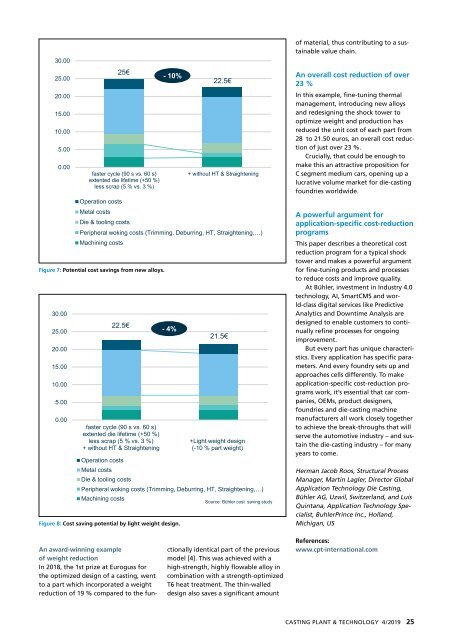CPT International 4/2019
Create successful ePaper yourself
Turn your PDF publications into a flip-book with our unique Google optimized e-Paper software.
30.00<br />
25.00<br />
20.00<br />
15.00<br />
10.00<br />
5.00<br />
0.00<br />
25€<br />
faster cycle (90 s vs. 60 s)<br />
extented die lifetime (+50 %)<br />
less scrap (5 % vs. 3 %)<br />
+ without HT & Straightening<br />
Operation costs<br />
Metal costs<br />
Die & tooling costs<br />
Peripheral woking costs (Trimming, Deburring, HT, Straightening,…)<br />
Machining costs<br />
Figure 7: Potential cost savings from new alloys.<br />
30.00<br />
25.00<br />
20.00<br />
15.00<br />
10.00<br />
5.00<br />
0.00<br />
22.5€<br />
faster cycle (90 s vs. 60 s)<br />
extented die lifetime (+50 %)<br />
less scrap (5 % vs. 3 %)<br />
+ without HT & Straightening<br />
- 10%<br />
- 4%<br />
22.5€<br />
+Light weight design<br />
(-10 % part weight)<br />
Operation costs<br />
Metal costs<br />
Die & tooling costs<br />
Peripheral woking costs (Trimming, Deburring, HT, Straightening,…)<br />
Machining costs<br />
Source: Bühler cost saving study<br />
Figure 8: Cost saving potential by light weight design.<br />
21.5€<br />
of material, thus contributing to a sustainable<br />
value chain.<br />
An overall cost reduction of over<br />
23 %<br />
In this example, fine-tuning thermal<br />
management, introducing new alloys<br />
and redesigning the shock tower to<br />
optimize weight and production has<br />
reduced the unit cost of each part from<br />
28 to 21.50 euros, an overall cost reduction<br />
of just over 23 %.<br />
Crucially, that could be enough to<br />
make this an attractive proposition for<br />
C segment medium cars, opening up a<br />
lucrative volume market for die-casting<br />
foundries worldwide.<br />
A powerful argument for<br />
application-specific cost-reduction<br />
programs<br />
This paper describes a theoretical cost<br />
reduction program for a typical shock<br />
tower and makes a powerful argument<br />
for fine-tuning products and processes<br />
to reduce costs and improve quality.<br />
At Bühler, investment in Industry 4.0<br />
technology, AI, SmartCMS and world-class<br />
digital services like Predictive<br />
Analytics and Downtime Analysis are<br />
designed to enable customers to continually<br />
refine processes for ongoing<br />
improvement.<br />
But every part has unique characteristics.<br />
Every application has specific parameters.<br />
And every foundry sets up and<br />
approaches cells differently. To make<br />
application-specific cost-reduction programs<br />
work, it’s essential that car companies,<br />
OEMs, product designers,<br />
foundries and die-casting machine<br />
manufacturers all work closely together<br />
to achieve the break-throughs that will<br />
serve the automotive industry – and sustain<br />
the die-casting industry – for many<br />
years to come.<br />
Herman Jacob Roos, Structural Process<br />
Manager, Martin Lagler, Director Global<br />
Application Technology Die Casting,<br />
Bühler AG, Uzwil, Switzerland, and Luis<br />
Quintana, Application Technology Specialist,<br />
BuhlerPrince Inc., Holland,<br />
Michigan, US<br />
An award-winning example<br />
of weight reduction<br />
In 2018, the 1st prize at Euroguss for<br />
the optimized design of a casting, went<br />
to a part which incorporated a weight<br />
reduction of 19 % compared to the functionally<br />
identical part of the previous<br />
model [4]. This was achieved with a<br />
high-strength, highly flowable alloy in<br />
combination with a strength-optimized<br />
T6 heat treatment. The thin-walled<br />
design also saves a significant amount<br />
References:<br />
www.cpt-international.com<br />
CASTING PLANT & TECHNOLOGY 4/<strong>2019</strong> 25

















